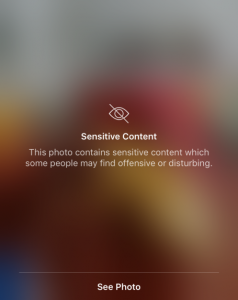Censorship is always a difficult subject where social media is concerned. Should the freedom of speech allow anything to be posted? Should content deemed unsuitable for thirteen year olds be allowed? What is suitable or unsuitable for thirteen year olds?
These are just three of the thousands of questions that are at the centre of the debate on censorship in social media.
We live in an age and time where censorship is over prevalent and the general consensus of the public is that we need to be allowed more freedom and transparency. However, there are plenty of valid arguments coming from those who support censorship too. This leaves social media platforms with the conundrum of having to decide where to draw the line and what to allow.
With most of the mainstream social media platforms such as Instagram and Facebook having a minimum age of thirteen they need to be aware of adult content. By allowing under eighteens to register and use the platforms they need to be increasingly diligent to ensure that no unsuitable content is displayed. This becomes difficult when they have to decide what is considered suitable or unsuitable as every country, culture and religion have very different opinions on what is acceptable and what is not.
The Censorship Debate
Over the past few years there have been countless instances of social media platforms being over sensitive and removing or banning content the public feel should have been shown.
Facebook has even been accused of censoring trending topics – and this has absolutely huge implications if true. If true, this means that Facebook have had the ability to decide what news trends and what gets brushed under the carpet. With a shocking 1.2 billion active users this means that over 10% of the world’s population are being affected by Facebooks censorship. Similar claims have risen about other social media platforms too. Facebook have denied this stating that it wasn’t even “technically feasible”.
With the number of claims coming from sources inside social media organisations, it would seem unlikely that all of these claims are unsubstantiated.
Instagram has been fighting a downhill battle regarding censorship since the platform first became popular. Since Instagram works with pictures and photos, ensuring that none of the content in the images displayed is of adult content or inappropriate in nature is paramount for both public support and for legal reasons.
In the past Instagram and its parent company Facebook have deleted photos and videos that it deemed inappropriate for the sites. They have perhaps been over zealous in regards to what has been deleted to allow them to stay on the right side of the law and of the general public opinion.
This has backfired time and time again in recent years.

The amount of content being removed has led to so much controversy and anger by freedom of speech advocators that the platforms have actually been forced into reinstating the content in many of these cases. Having to back track a decision makes a company appear weak and ineffective, and when these decisions regard access to public content the repercussions have a tendency to escalate extremely quickly.
While it is understandable that some content requires censorship on social media, many people disagree with the amount of censorship that is implemented at the moment. Pornographic content is available all over the internet and is not suitable for thirteen year olds – therefore most people have no issues with this being censored on social media.
What about cultural differences?
Instagram and Facebook both seem to lack when it comes to Cultural understanding. This can be tested quickly and simply by anyone at home. If you post a picture up to either platform of a woman from the West Papua region of Indonesia – what happens? It is instantly flagged as inappropriate content and deleted. This is interesting as it is content that is not regarded as pornographic or inappropriate in nature by most.
As interesting as this is, it is hardly surprising. The social media giants have been over censoring since the beginning and have shown little interest in slowing down or changing the way they censor images.
Instagram Change Censorship Style
Instagram however has finally made a step which could mean a win for the anti-censorship group.
Instagram have described the newly implemented feature – the sensitive content filter.
“Soon you may notice a screen over sensitive photos and videos when you scroll through your feed or visit a profile. While these posts don’t violate our guidelines, someone in the community has reported them and our review team has confirmed they are sensitive. This change means you are less likely to have surprising or unwanted experiences in the app. If you’d like to see a post that is covered with a screen, simply tap to reveal the photo or video.”

This could mean that some of the content that previously being removed by Instagram might now be allowed to remain on the platform. If this is the case then the sensitive content filter is going to be applauded by freedom of speech advocators across the world.
However, it could mean something else entirely.
Instagram may still remove the content it would have removed previously and start censoring content that would have been displayed publically prior to the introduction of the ‘sensitive content’ filter. This would be a win for the pro-censorship groups and a massive step back for those trying to push freedom of speech and expression through social media.
The exact purpose of the new feature will remain unclear for the time being. The is no doubt that people on both sides of the censorship debate will currently be putting the filter to the test to decide which way Instagram has decided to implement the feature.
